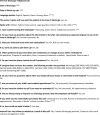Improving Documentation of Postdischarge Issue Mitigation during Postdischarge Phone Calls
- PMID: 36382143
- PMCID: PMC9649269
- DOI: 10.1097/pq9.0000000000000618
Improving Documentation of Postdischarge Issue Mitigation during Postdischarge Phone Calls
Abstract
Postdischarge phone calls (PDPCs) are recommended to identify and mitigate postdischarge issues such as missed follow-up appointments, medication errors, and failure to activate contingency plans. A current state assessment showed variability in documenting PDPC content and postdischarge issue mitigation. Therefore, the primary aim was to improve the postdischarge issue mitigation documentation rate from 65% to 100% over 16 months.
Methods: An interdisciplinary quality improvement team used the Model for Improvement to perform planned sequential interventions over 16 months. The outcome measure was documentation of postdischarge issue mitigation. Process measures included PDPC template use and completion and postdischarge issue identification. Balancing measures included call attempts and caller perceptions of ease of documentation. Interventions included creating a flowsheet note template, creating caller template training sessions, and sharing team data and feedback. We gathered data via reports generated from the electronic medical record, chart review, and survey. Data were analyzed using statistical process control charts and established rules for detecting special cause variation.
Results: The postdischarge issue mitigation documentation increased from 65% to 91% over 16 months. Template use and completion increased from 0% to 100% and 98%, respectively. The number of postdischarge issues identified remained unchanged. Call attempts increased from 40% to 59%. Caller perceptions remained unchanged.
Conclusions: Documentation of postdischarge issues and issue mitigation promotes adequate communication with the patient's care providers, improving the quality and safety of care. Data sharing to promote team engagement was the key factor in improving documentation of postdischarge issue mitigation.
Copyright © 2022 the Author(s). Published by Wolters Kluwer Health, Inc.
Figures






References
-
- Heath J, Dancel R, Stephens JR. Postdischarge phone calls after pediatric hospitalization: an observational study. Hosp Pediatr. 2015;5:241–248. - PubMed
-
- Lazar A, Rappaport DI, Sharif I, et al. . Factors associated with pickup of pediatric discharge prescriptions. Hosp Pediatr. 2019;9:440–446. - PubMed
-
- Rehm KP, Brittan MS, Stephens JR, et al. . Issues identified by postdischarge contact after pediatric hospitalization: a multisite study. J Hosp Med. 2018;13:236–242. - PubMed
-
- Yale S, Bauer SC, Stephany A, et al. . One call away: addressing a safety gap for urgent issues post discharge. Hosp Pediatr. 2021;11:632–635. - PubMed
LinkOut - more resources
Full Text Sources
Miscellaneous
